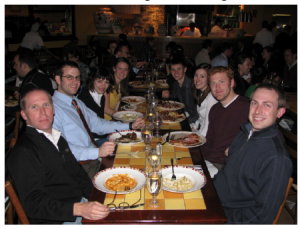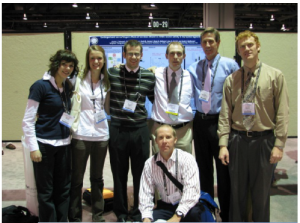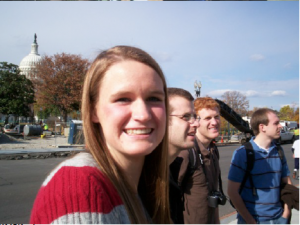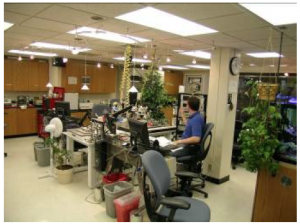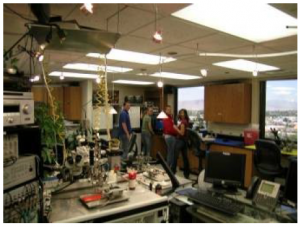Dr. Scott Steffensen, Department of Psychology
Objectives
The main objective of this study was to characterize the role of GABA neurons in the ventral tegmental area in cocaine addiction. Research in my lab is dedicated to the elucidation of brain substrates underlying drug addiction. Elder Boyd K. Packer has stated, “It is my conviction, and my constant prayer, that there will come through research, through inspiration to scientists if need be, the power to conquer narcotic addiction through the same means which cause it.”(Packer 1989). This plea from Elder Packer is emblazoned on a poster at the entrance to my laboratory to remind us of the seriousness of addiction research and the stranglehold that addiction has on the lives of many of God’s children. We study critical brain circuits involved in natural rewarding behaviors and drug addiction. I proposed a mentored project in my laboratory to characterize the neurophysiological substrates of cocaine addiction. We have made significant progress on this project thanks to this funding and the students under my purview. Indeed, we published an original, peer-reviewed article in The European Journal of Neuroscience in 2008 on cocaine effects on VTA GABA neurons. Here is the citation for that work.
Steffensen, S.C., Taylor, S.R., Horton, M.L., Barber, E.N., Lyle, L.T., Stobbs, S.H. and Allison, D.W. Cocaine disinhibits dopamine neurons in the ventral tegmental area via use-dependent blockade of GABA neuron voltage-sensitive sodium channels. Eur. J. Neuroscience 28 (2008) 2028-2040.
Also, I have attached a pdf reprint of this article with this report. Two BYU undergraduate students and 3 BYU graduate students are co-authors on this article. This journal is a Tier 1 high impact journal in the field of Neuroscience. I am very proud of this work on many levels, both from a scientific and mentoring standpoint. We learned a lot from this experience, which I believe led to the decision by two of my undergraduate students to attend graduate school rather than medical school. Indeed, one of the co-authors was Seth Taylor, the 2008 Neuroscience valedictorian. He is currently attending graduate school at Yale. In association with this mentoring grant, I requested travel funds for 8 psychology/neuroscience students to attend the Society for Neuroscience meeting in Washington, DC in November 2008 and research stipends for 4 student research assistants to work directly on this project. These funds were used directly for that purpose. For example, eight undergraduate students including Micah Hansen, Seth Taylor, Jordan Yorgason, Christine Walton, JD Wilcox, Cory Everette, Caitlin Askew and Emily Anderson accompanied me to the Neuroscience Meeting in Washington, DC. I have taken students to the Neuroscience meeting the past 4 years with much-appreciated internal BYU MEG funds (2003-2005) and by sacrificing my travel funds last year when I did not have an ORCA MEG. I am struck by how they are influenced by attendance at these meetings. Many have made contacts at these meetings that have resulted in their admittance into graduate programs, professional programs, etc… Indeed, some have changed their career track as a result of attending them, and now plan on pursuing academic rather than professional careers. In my opinion, this is the single-most important event in their undergraduate career and as their mentor I would like to support as many promising students as possible in this enterprise. I am so grateful for the support I have been given in this regard.
Completion of Academic Objectives
We proposed three Specific Aims/Experiments in association with this MEG grant: Experiment 1. Pharmacology of cocaine inhibition of VTA GABA neuron excitability and electrical coupling under naïve conditions and Experiment 2. To evaluate the effects of cocaine and dopamine on electrical coupling between VTA GABA neurons in midbrain slices and adaptations of VTA GABA neuron electrical coupling and Experiment 3. Neuroadaptations in critical VTA gene products in association with ethanol and cocaine reinforcement
The first two experiments were completed as described above and results from these studies are published in the 2008 Eur J. Neuroscience article. The third is currently in progress. It is the Thesis Project of my Psychology Graduate Student Devin Taylor. Results from his study and the Eur J. Neuroscience article will form the Preliminary Data for an NIH NIDA grant on cocaine that I plan to submit Summer 2009. It will involve the determination of the molecular adaptations of critical gene products in the VTA in association with cocaine dependency. Thus, the deliverables to BYU, the scientific community, and to the community in general in association with this MEG include: 1) Basic discoveries regarding the neurophysiological substrates involved in drug addiction; 2) Elucidation of pharmacological and behavioral strategies for treatment of addiction; 3) Meaningful mentoring environment for students pursuing professional and academic careers; and 4) An understanding of the addiction process will help improve the emotional, spiritual, and physical well-being of our brothers and sisters whose lives are altered due to addiction’s stranglehold on their lives.
Evaluation of Mentoring Environment
The three pictures below show most of the 8 students that accompanied me to the Neuroscience Meeting in Washington, DC.
Students under my purview are extremely motivated and generally aspire towards advanced degrees or professional schools. We are usually the rate-limiting step in their education. Given the academic parity amongst applicants to graduate and professional schools, research experience distinguishes them from the fray. We provide a structured research experience whose academic deliverables are scientific articles, presentations at scientific conferences, etc…Many, if not all, of our students have been placed in graduate and professional schools. Indeed, three of my five employees over the past 5 years were former mentored students. So, I try to encourage them towards careers aligned somewhat with our research. I believe that the laboratory is the best teaching environment for the sciences and that my lab offers an outstanding research mentoring environment for the students. The anesthetized rat single-unit recording suites and a student are shown in my lab in the left picture below and some of the behavioral operant chambers are shown with students in the right picture below.
This semester, for example, I have 28 students that I am mentoring in NS449R, which is typically the norm Fall/Winter Semesters. I have developed personal and professional relationships with the students. Besides daily informal discussions, the students meet together twice per semester as a group to discuss the progress on different projects. One or two social gatherings at my home are the norm. In addition, our more senior students submit ORCA scholarships that pertain to their assigned projects. Eight of them have done so for 2009, and three were awarded. Students are given ample opportunity for growth in skills and increase in responsibility in their project. They are taught electrophysiological and behavioral methods and allowed time to assimilate the somewhat arcane nature of the technology. I am fully aware of the learning curve for this technology and appreciate the long-term nature of acquiring skills therein. The more seasoned students will be made stewards over their experiments, wherein they will be wholly responsible for the technical and analytical outcomes. The two projects outlined above are organized under my supervision; however, the graduate students will be directly responsible for specific projects wherein they will manage 5 students each. Students will be involved in projects wherein an environment of discovery and creativity will be fostered by the active, daily participation of myself and the graduate students. As mentioned above, students are now and will continue to be included as co-authors on papers, according to their degree of effort and participation in the study. These decisions will be made under my advisement. Finally, we are committed to the future of our students. We will educate them as to their career options. We will actively recommend them for positions after graduation. Finally, I will even employ them if I can. Indeed, I will be employing two of them following April graduation 2009.
Budget Summary
Stipends: The original budget was intended for the 2007 Neuroscience Meeting in San Diego.
However, the MEG was not funded by ORCA in the first review, but was eventually covered by the College of FHSS. Notwithstanding this change, the funds were used for nearly identical purposes in 2008 to pay for student stipends, travel to the Neuroscience meeting in Washington, DC, supplies, etc…,
We requested funds to cover 4 senior student research assistants at $8/hr for 10 hrs/wk for 40 weeks of the year. Total stipend costs were: $9,900
Supplies: Housing costs for the rats/mice used in this study was $2,000
Travel: Eight undergraduate students attended the Neuroscience meeting in Washington, DC
- Total costs=$6,600
Laboratory Meetings: Orientation and mid-semester luncheons at BYU two times/yr for 28-35 undergraduate and graduate students under my purview and light lunches for senior-level undergraduate student/graduate student lab meetings on multiple occasions throughout Fall/Winter semesters. Total costs: $1000
Total costs: $19,500.
References
- Packer, B. K. (1989). Revelation in a changing world. Ensign: 14.

